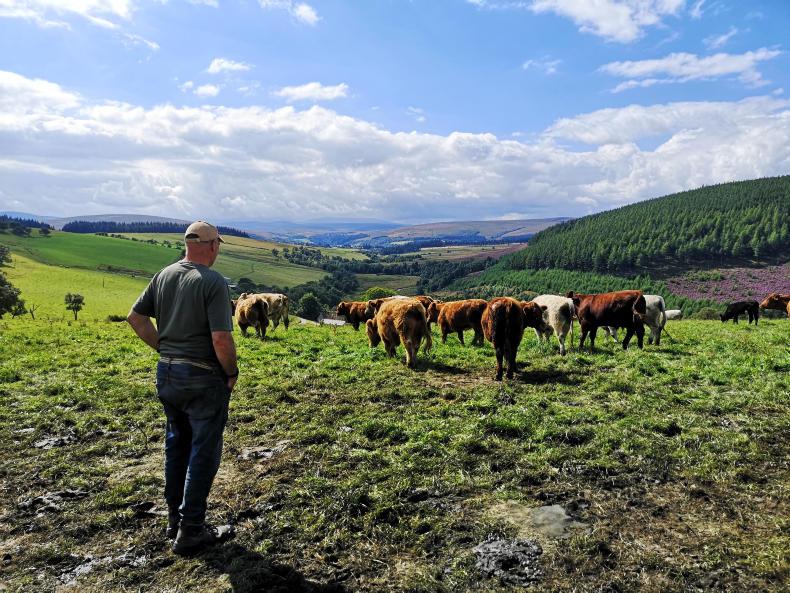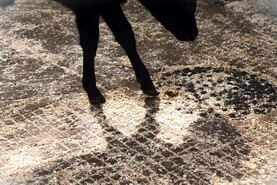Andy and Debbie Duffus are starting to reap the rewards of decisions made over the last four years. We headed to Auchriachan to hear what has been happening.
Sheep
With the work they have been doing to improve soil fertility over the last four years, the Duffus team are growing a lot more grass than previously. This has led to the Mules performing a lot better this year as they were able to keep them on the in-bye land. Most years, they go to the hill until weaning when the lambs come in-bye and the ewes go back to the hill. Instead, after marking, they went on to a grazing rotation with the Shorthorn cross and Highland cross yearlings. This has led to far greater lamb growth and the ewes are in great condition.

Andy and his father weighing lambs for sale.
This has meant that they have been able to take a draw of 39 fat lambs from the Mule ewes already. They went off last week and averaged £77 a head. While they were going through them, they found there were a lot of lambs in the 38kg to 42kg weight range so they are expecting a good draw again next week. While they were going through, they were all treated with Crovect to protect against maggots as they seem to be a major problem just now.
The blackies were weaned three weeks ago immediately after clipping. The ewes were put back to the hill and the lambs have gone on to their usual rotation on the silage aftermaths at Auchriachan. This intention is to go through them next week and draw off the fat ones.
Hill cows
Last year’s stot calves were grazing on a rotation with the Mule ewes at Glenconglass. Two Fridays ago, we picked the first 15 and they went off to Thainstone.
They averaged 436kg at 16.5 months old and came to £855. Daily liveweight gain from birth to turnout this spring averaged 0.84kg a day, meaning they went to grass at 339kg at a year old. At grass, they added another 97kg from a daily liveweight gain of 0.69kg a day. Overall, they have done 0.8kg a day for life and the Duffuses are very pleased with this for the type of cattle they are. Interestingly, the calves that were born in between January and March did not perform as well as the calves born to green grass in April and May, with those before April doing 0.76kg/day for life and the those born to green grass doing 0.81kg/day.

Andy's farm is in the Cairgorm mountain range.
The Shorthorns and Highlanders are grazing on the hill just now. Bulls have been with them since the middle of June and are due out at the beginning of next month. Their calving was a bit more drawn out this year due to a number of cows that had been bought in-calf. This meant that calving started in February and finished with a late one in July.
The Duffuses were prepared for this and with the growing season up here in mind, the bulls didn’t go in until mid-June this year and they will be pulled from the cows in mid-September, meaning calving will be much tighter for next year.
Continental cows
The autumn herd has been weaned. The calves are now on a grazing rotation with the remainder of the hill stots. The cows will be moved to the hill parks behind the yard at home to keep a close eye on in the runup to calving.
The spring herd is still on a loose rotation of some improved land. Like the hill cattle, the bull will come away from them in mid September.
We plan to scan early again this year and cull out any empty cows. For winter, we have 6 hectares of swedes at home for them for the first half of winter. On the whole, they have been fairly successful, although the rabbits and deer did damage to some of the crop.
Fodder
There are stubble turnips in the ground again this year for the sheep.

Good growth in Andy's stubble turnips.
Once the lambs have finished on the grass, they will go on to the turnips to fatten. As already mentioned, a lot of work has been put into soil fertility over the last four years and the amount of grass they are producing is increasing each year. This spring saw the farm with a good carryover of silage from last winter. However, they still have second cut to go and added to the silage tally in the yard just now, they are wondering if they’ll even need to open the silage pit this year.
Andy’s close call
Andy had a very near miss last month when spreading dung on silage aftermaths. The tractor pulling the spreader lost grip, jackknifed and went out of control. It slid down a steep bank and had the tractor not ran into a tree, things could have been much worse. As it is, he had a night in the hospital and has broken ribs and several stitches.
It is a bit of ground that Andy knows well and yet still accidents happen. He is very lucky to have not been too badly injured and it serves as a reminder to us all that we operate in an industry with a lot of risks. At all times and especially in this busy season, stay safe out there.
Andy and Debbie Duffus are starting to reap the rewards of decisions made over the last four years. We headed to Auchriachan to hear what has been happening.
Sheep
With the work they have been doing to improve soil fertility over the last four years, the Duffus team are growing a lot more grass than previously. This has led to the Mules performing a lot better this year as they were able to keep them on the in-bye land. Most years, they go to the hill until weaning when the lambs come in-bye and the ewes go back to the hill. Instead, after marking, they went on to a grazing rotation with the Shorthorn cross and Highland cross yearlings. This has led to far greater lamb growth and the ewes are in great condition.

Andy and his father weighing lambs for sale.
This has meant that they have been able to take a draw of 39 fat lambs from the Mule ewes already. They went off last week and averaged £77 a head. While they were going through them, they found there were a lot of lambs in the 38kg to 42kg weight range so they are expecting a good draw again next week. While they were going through, they were all treated with Crovect to protect against maggots as they seem to be a major problem just now.
The blackies were weaned three weeks ago immediately after clipping. The ewes were put back to the hill and the lambs have gone on to their usual rotation on the silage aftermaths at Auchriachan. This intention is to go through them next week and draw off the fat ones.
Hill cows
Last year’s stot calves were grazing on a rotation with the Mule ewes at Glenconglass. Two Fridays ago, we picked the first 15 and they went off to Thainstone.
They averaged 436kg at 16.5 months old and came to £855. Daily liveweight gain from birth to turnout this spring averaged 0.84kg a day, meaning they went to grass at 339kg at a year old. At grass, they added another 97kg from a daily liveweight gain of 0.69kg a day. Overall, they have done 0.8kg a day for life and the Duffuses are very pleased with this for the type of cattle they are. Interestingly, the calves that were born in between January and March did not perform as well as the calves born to green grass in April and May, with those before April doing 0.76kg/day for life and the those born to green grass doing 0.81kg/day.

Andy's farm is in the Cairgorm mountain range.
The Shorthorns and Highlanders are grazing on the hill just now. Bulls have been with them since the middle of June and are due out at the beginning of next month. Their calving was a bit more drawn out this year due to a number of cows that had been bought in-calf. This meant that calving started in February and finished with a late one in July.
The Duffuses were prepared for this and with the growing season up here in mind, the bulls didn’t go in until mid-June this year and they will be pulled from the cows in mid-September, meaning calving will be much tighter for next year.
Continental cows
The autumn herd has been weaned. The calves are now on a grazing rotation with the remainder of the hill stots. The cows will be moved to the hill parks behind the yard at home to keep a close eye on in the runup to calving.
The spring herd is still on a loose rotation of some improved land. Like the hill cattle, the bull will come away from them in mid September.
We plan to scan early again this year and cull out any empty cows. For winter, we have 6 hectares of swedes at home for them for the first half of winter. On the whole, they have been fairly successful, although the rabbits and deer did damage to some of the crop.
Fodder
There are stubble turnips in the ground again this year for the sheep.

Good growth in Andy's stubble turnips.
Once the lambs have finished on the grass, they will go on to the turnips to fatten. As already mentioned, a lot of work has been put into soil fertility over the last four years and the amount of grass they are producing is increasing each year. This spring saw the farm with a good carryover of silage from last winter. However, they still have second cut to go and added to the silage tally in the yard just now, they are wondering if they’ll even need to open the silage pit this year.
Andy’s close call
Andy had a very near miss last month when spreading dung on silage aftermaths. The tractor pulling the spreader lost grip, jackknifed and went out of control. It slid down a steep bank and had the tractor not ran into a tree, things could have been much worse. As it is, he had a night in the hospital and has broken ribs and several stitches.
It is a bit of ground that Andy knows well and yet still accidents happen. He is very lucky to have not been too badly injured and it serves as a reminder to us all that we operate in an industry with a lot of risks. At all times and especially in this busy season, stay safe out there.









 This is a subscriber-only article
This is a subscriber-only article










SHARING OPTIONS: